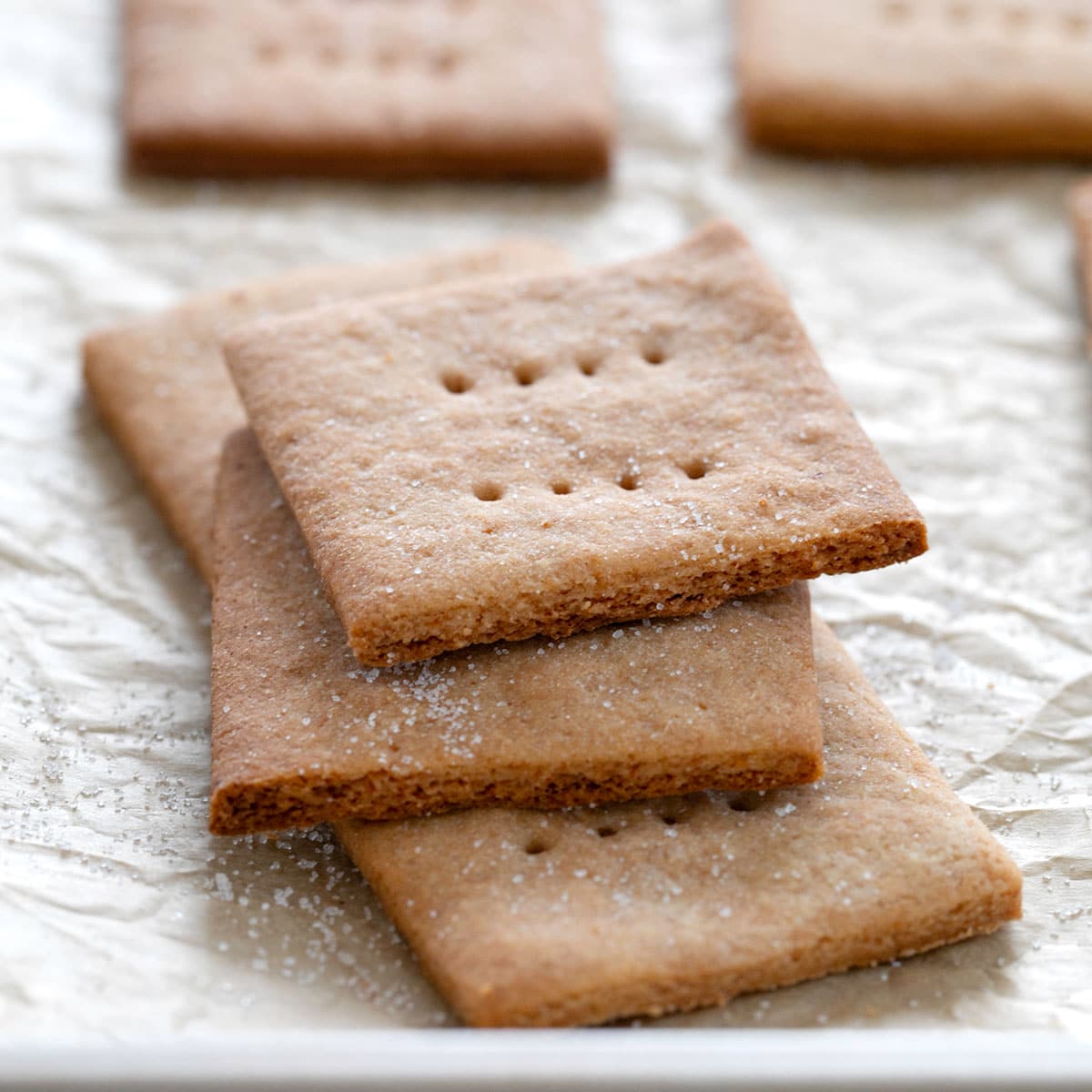

These gluten free graham crackers have that snappy, crisp texture with the wheat-y taste of Nabisco grahams and subtle depth of flavor from molasses and honey.
They're absolutely perfect for making into gluten free graham cracker crumbs, and all the things that graham cracker crumbs make possible, like no bake desserts and cookie crust pies. The possibilities are endless for these humble little gf cookies!
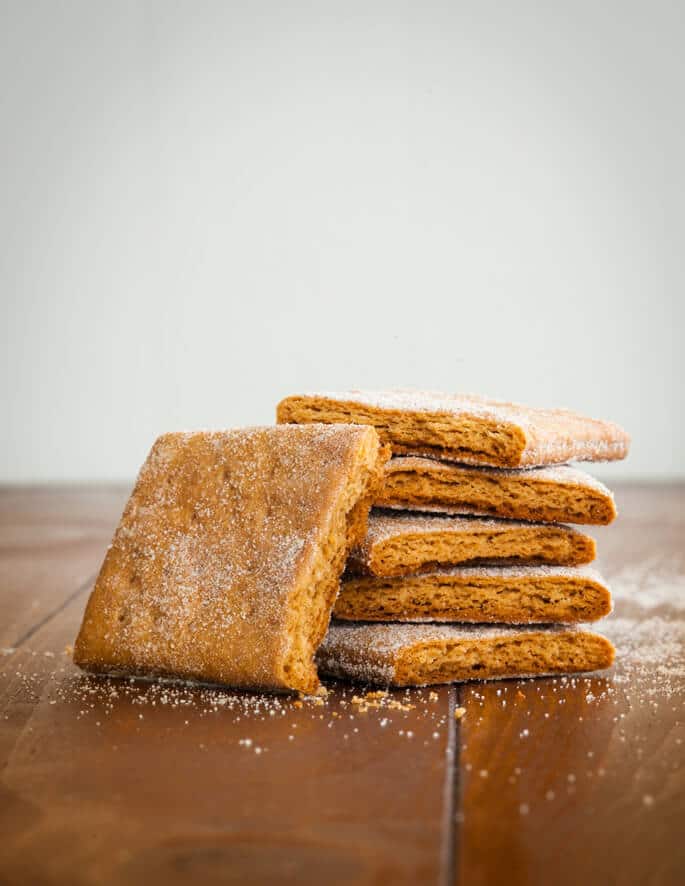
WANT TO SAVE THIS RECIPE?
What makes these gluten free graham crackers special
Did you know that you can buy gluten free graham crackers (at least in the U.S.)? There are a few brands that I've tried, and they're all perfectly fine, but they lack the depth of flavor of Nabisco, or our homemade grahams. The texture also tends to be less crispy and more dense, making them somewhat hard to eat.
Don't get me wrong, though, as I'm so super grateful that store-bought gluten free graham crackers exist. It's not always practical to make them from scratch, like on bonfire s'mores nights at my son's sleepaway camp when he was small. They easily stocked gf marshmallows and packaged gf graham crackers.
But making your own gluten free graham crackers means that you can experience the same taste, texture, and flavor as the ones that Nabisco makes. And it's so easy to do—with the right recipe, of course.
How to customize these gluten free graham crackers
When you make your own, of course, you can make them with or without the cinnamon-sugar topping, and even with or without the ground cinnamon in the dough. Nothing makes a better cookie-crumb crust for lemon meringue pie than these crispy, crunchy, authentic grahams.

How to make gluten free graham crackers
There are no hard-to-find ingredients in this recipe, and if you're convinced you can't roll out cookie or cracker dough like a pro, read through the step by step instructions carefully.

Ingredients
Here are the simple gluten free pantry ingredients you'll need to make gluten free graham crackers at home:
- All purpose gluten free flour (with xanthan gum) (I used Better Batter please be sure to use one of my recommended blends and measure by weight!)
- Baking soda (helps neutralize acid and aids in browning)
- Baking powder (adds lift to help create that crispy, honeycomb texture)
- Salt (enhances and brightens other flavors)
- Granulated sugar (adds sweetness, tenderness, and helps make the cookies crispy)
- Light brown sugar (adds more moisture and depth of flavor, plus sweetness)
- Butter (adds buttery flavor, tenderness, and crispness)
- Molasses (adds sweetness, plus that characteristic caramel taste)
- Honey (adds sweetness, with a light floral flavor)
- Egg (acts as a binder to hold everything together)
- Vanilla extract (adds flavor, and enhances other flavors)
Making the graham cracker dough

Here's how to make the raw graham cracker dough:
- First, whisk together the gluten free flour, xanthan gum, baking powder, baking soda, and salt in a large mixing bowl.
- Next, whisk in the granulated sugar, and then the brown sugar. The granulated sugar will whisk right into the dry ingredients, but you'll need to mix the brown sugar and press down the mixing spoon against the side of the bowl whenever you find any clumps of brown sugar.
- Add the melted butter, molasses, honey, beaten egg, and vanilla extract, and mix to combine. If you make a well in the center of the dry ingredients and pour the wet ingredients into it, you can mix everything together at the same time and still have a cohesive dough.
- The dough will be thick and shiny, and should hold together well.
Rolling out, shaping, and baking gluten free graham cracker dough
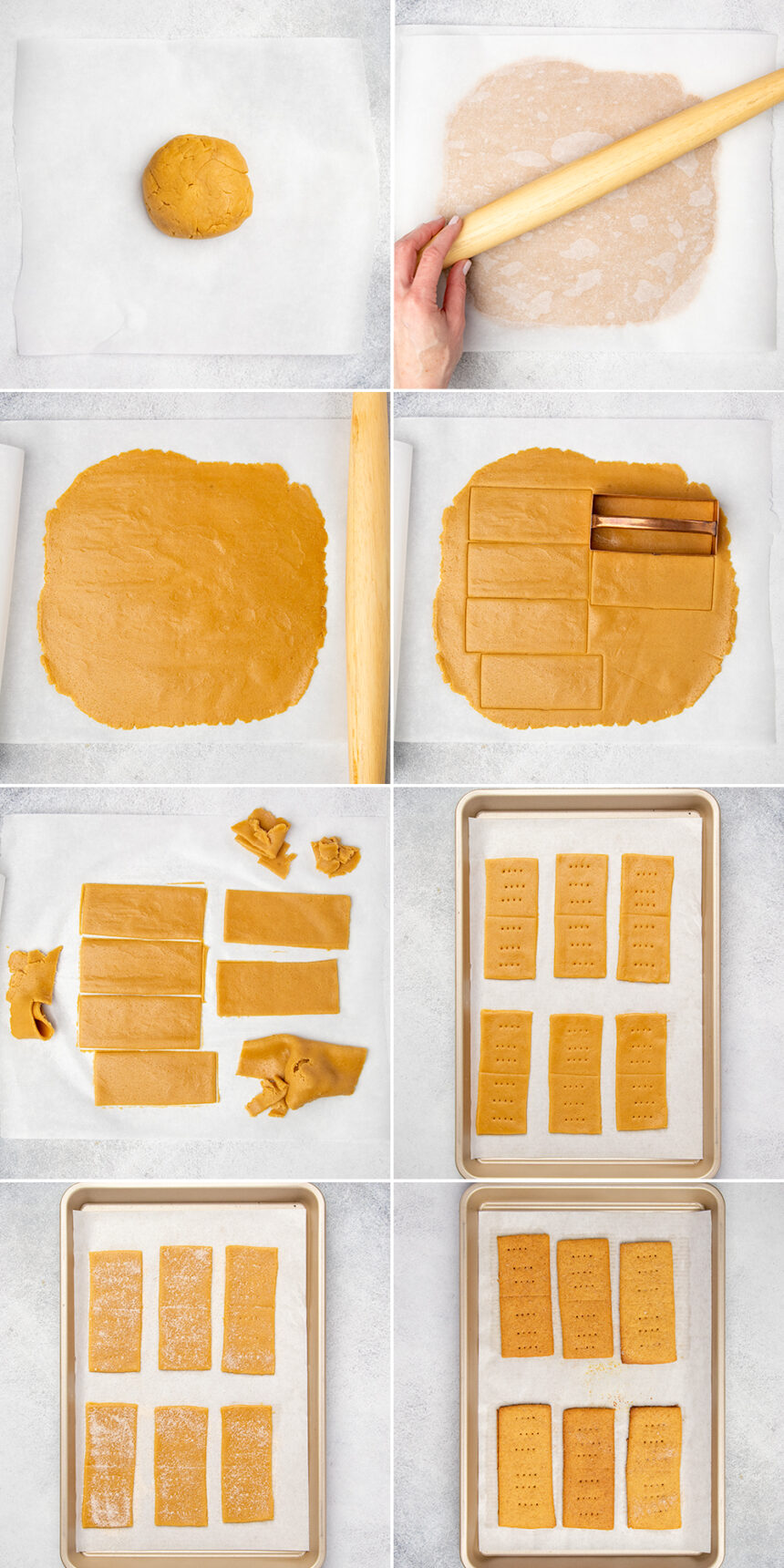
The next steps in the recipe are all about rolling out the dough until it's about 1/4-inch thick, cutting out rectangular shapes, piercing the raw pieces of dough with the tines of a fork to allow steam to escape during baking (this prevents bubbles from forming in the dough), sprinkling with cinnamon sugar (or not!), and baking until firm.
Tips for rolling out cracker dough
It's not difficult to roll out raw cookie or cracker dough, but it can seem intimidating if you're not comfortable with the process. Here are a few tips for rolling out and handling the dough like a pro:
- It's a rolling pin, not a pressing pin. Rather than using a rolling pin to press the dough, concentrate on the rolling motion as you flatten the dough. Rolling back and forth makes it easier to get your dough to an even thickness. Applying too much pressure leads to fragile, overly thin parts.
- Don't worry about the shape. If you don't have a 2-inch x 4-inch rectangular cookie cutter, try to relax about getting your shapes into precisely the same size as one another. You can break out the ruler and measure each just right, but after the first few, I'd really recommend you eyeball it. It won't matter that much to the final result.
- Remove the extra dough first. To make transfer of the rectangles of dough easier, try pulling away the surrounding dough to expose the cut out shapes. Then, turn the shape onto one of your palms, and peel off the parchment paper from the back of the shape.
- Go by feel. Your hands are much more sensitive to differences in thickness than your eyes as you roll. Running your hands lightly across the dough will tell you everything you need to know about where to roll thinner, where to leave the dough be. Trust those hands! They're a cook's best tools.
- Try chilling the dough. If you are having trouble getting clean lines when cutting out dough or the dough is just too difficult to handle, roll it out, and then chill the dough in the refrigerator or freezer. Also, make sure you're not rolling the dough too thin. That will make it harder to handle, too.

Substitutions for these gluten free graham cracker ingredients
Gluten free dairy free graham crackers
If you're dairy free, replace the melted butter with an equal amount, by volume, of Spectrum nonhydrogenated vegetable shortening, plus 1 to 2 teaspoons of unsweetened almond milk or your favorite nondairy milk.
Gluten free egg free graham crackers
Since there is only one egg in this recipe, I feel pretty confident saying that a “chia egg” (1 tablespoon ground white chia seeds + 1 tablespoon lukewarm water, mixed and allowed to gel). I don't recommend a “flax egg,” as flax has a strong flavor that would compete with the flavor balance in the recipe.

FAQs
No! Graham crackers are traditionally made with a combination of different types of wheat flours: conventional all purpose flour and graham flour, which is a coarsely ground wheat flour. They are definitely not gluten free—unless you make them that way or buy them that way!
Unsulphured molasses is the most common type of molasses you'll find in the regular grocery store. It's not been “sulphured,” which is a process by which molasses made from un-matured sugar cane is treated with sulphur during sugar extraction.
Yes! You can use these gf graham crackers to make either a baked or an unbaked gluten free graham cracker crust by adding melted butter to crushed crackers. This recipe will make enough for 2 standard-size gf graham cracker crusts.
There are a few brands that make packaged gluten free graham crackers. None of them is as good as what you'll make with this homemade gf graham cracker recipe, but sometimes you need a quick shortcut! Here are the brands I know well:
Kinnikinnick “S'moreables graham style crackers” are pretty easy to find in larger grocery stores, but they are relatively bland-tasting.
Schar brand Honeygrams are the best-tasting gf graham crackers I've found—but they're quite expensive.
Pamela's brand gluten free graham crackers are pretty good, but they are made in a facility that is shared with wheat, so check in with your own risk tolerance.
Did you let the melted butter cool before you added it to the mixture? If melted butter is too warm, it won't incorporate fully into the dough and will make it seem greasy. Try letting the raw dough sit for a bit so the flours can absorb the fat.
If you didn't make any ingredient substitutions, especially with the gluten free flour blend, and you measured by weight, not volume, you may not have baked your graham crackers for long enough. You don't want them to burn, but they're not done until they are golden brown all over, plus dry and firm to the touch. If they're still kind of shiny, they're not done yet.
Yes! Once they are completely cool, you can put these crackers into a food processor and pulse until they have the texture of coarse crumbs, and then use them to make a cookie crumb crust. Just follow the instructions in our recipe for gluten free graham cracker crust to make either a baked crust, or a no-bake crust. You can use these graham crackers in any recipe where you might have used wheat-based graham crackers before.
Warm weather months absolutely demand graham cracker crumbs. Now, you'll be ready! Looking for more recipes that call for gluten free graham crackers? Try the easiest no bake cheesecake and our gluten free key lime pie. Or use them exactly as you always have in your favorite pie that has a naturally gluten free filling.
Gluten Free Graham Crackers | Just Like Nabisco!
Ingredients
For the dough
- 2 cups (280 g) all purpose gluten free flour blend (I used Better Batter; click thru for full info on appropriate blends)
- ¾ teaspoon xanthan gum omit if your blend already contains it
- ¼ teaspoon baking soda
- ¼ teaspoon baking powder
- ⅛ teaspoon kosher salt
- 1 teaspoon ground cinnamon optional
- ¼ cup (50 g) granulated sugar
- ⅓ cup (72 g) packed light brown sugar
- 6 tablespoons (84 g) unsalted butter melted and cooled
- 2 tablespoons (42 g) honey
- 2 tablespoons (42 g) unsulphured molasses
- 1 (50 g (weighed out of shell)) egg at room temperature, beaten
- ½ teaspoon pure vanilla extract
For the topping (optional)
- ½ cup (100 g) granulated sugar
- 1 ½ teaspoons ground cinnamon
Instructions
- Preheat your oven to 325°F. Line rimmed baking sheets with unbleached parchment paper and set them aside.
Make the dough.
- Prepare and shape the dough. In a large bowl, place the flour, baking soda, baking powder, salt, optional cinnamon and granulated sugar, and whisk to combine well. Add the brown sugar and whisk and mix again, working out any lumps in the brown sugar by pressing the clumps against the side of the mixing bowl with the back of the spoon.
- Create a well in the center of the dry ingredients and add the melted butter, honey, molasses, egg and vanilla, and mix to combine.
- Knead the dough together with your hands, if necessary, to bring it together into a cohesive ball.
- Transfer the dough to a piece of unbleached parchment paper sprinkled lightly with gluten free flour, and, sprinkling lightly with flour as necessary to prevent sticking, roll out the dough until it is about 1/4-inch thick.
- You can also skip sprinkling with additional flour. Simply top the dough with a second sheet of parchment paper, and roll out the dough until it's about 1/4-inch thick. Before cutting out shapes, remove the top sheet of parchment paper.
- Cut into 2 x 4-inch rectangles (or use a 2 x 4-inch rectangular cutter to cut out shapes) and place them about 1-inch apart from one another on the prepared baking sheets.
- To make transfer of the rectangles of dough easier, try pulling away the surrounding dough to expose the cut out shapes. Then, turn the shape onto one of your palms, and peel off the parchment paper from the back of the shape. Carefully place on the prepared baking sheet.
- Gather and reroll the scraps to cut out more crackers until you’ve used up the dough.
- Place the cinnamon and sugar from the topping, if using, in a small bowl and whisk to combine well.
- Combine the topping ingredients in a small bowl, and sprinkle the rectangles evenly with the optional cinnamon-sugar mixture.
- Place the baking sheets, one at a time, in the center of the preheated oven and bake until the crackers are golden brown all over and dry and firm to the touch, about 15 minutes. Do not allow the graham crackers to burn. They will brown faster if you've used the cinnamon-sugar topping.
- Remove from the oven and allow to cool completely on the baking sheets. They will crisp as they cool.
- The crackers can be stored in a sealed glass container at room temperature and should maintain their texture for at least 5 days.
- For longer storage, seal them tightly in a freezer-safe wrap or bag and freeze for up to 2 months. If you freeze them, they will lose some of their crispness but they'll still be delicious. Defrost at room temperature.
Notes
Nutrition
WANT TO SAVE THIS RECIPE?
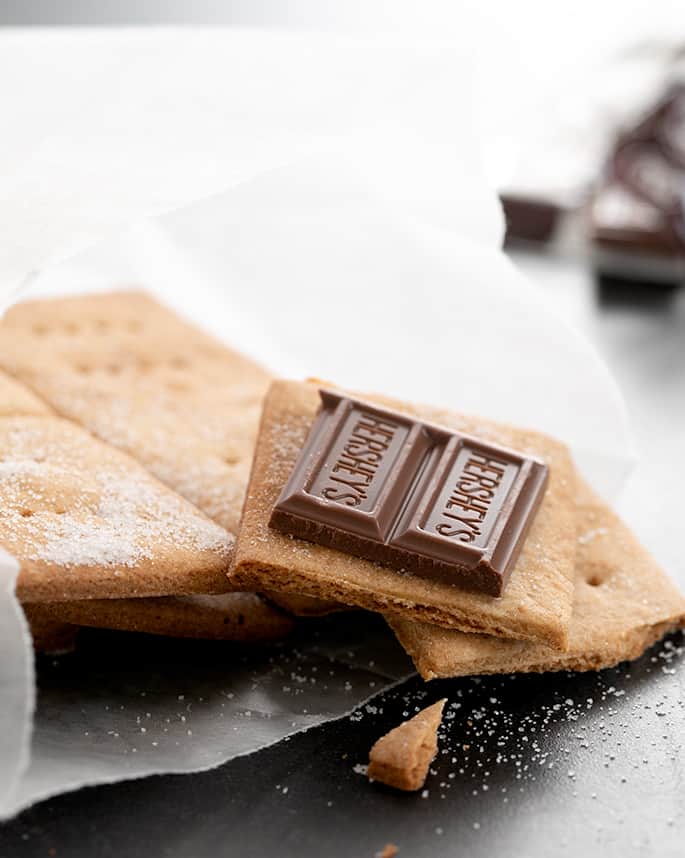

Thanks for stopping by!
Hi, I’m Nicole. I create gluten free recipes that really work and taste as good as you remember. No more making separate meals when someone is GF, or buying packaged foods that aren’t good enough to justify the price. At Gluten Free on a Shoestring, “good, for gluten free” just isn’t good enough! Come visit my bio!

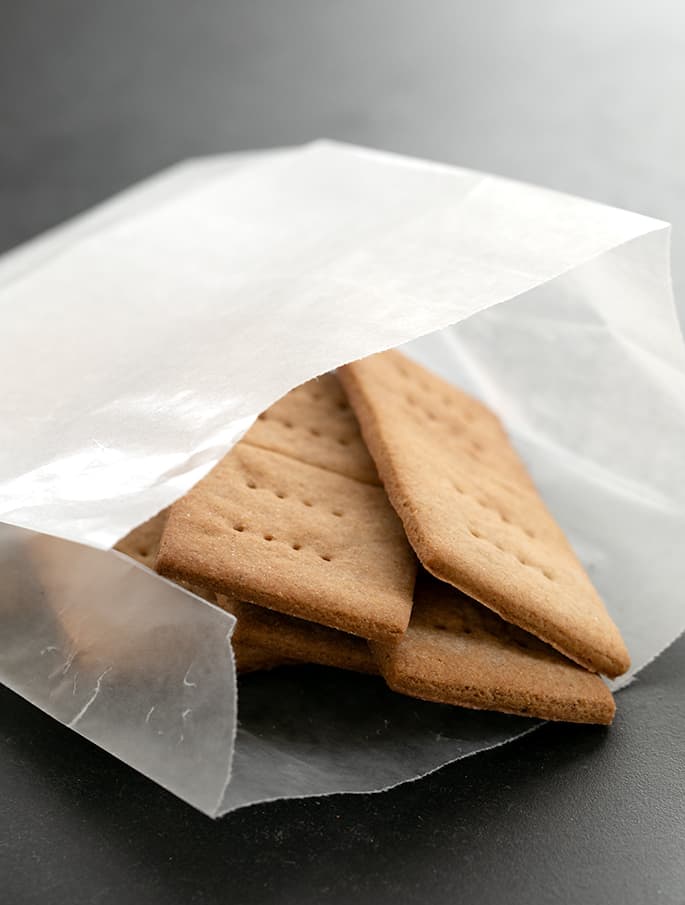


JaneDoh says
These were a huge hit with my family – I used a few for a cheesecake crust, and the rest were chomped down quick. Although not recommended I used Robin Hood all purpose gluten free blend. I figured it would at least make a tasty snack with tea, even if they didn’t turn out cracker-like. I used 320 g (the stated equivalent of 2 cups for that brand), with no other changes. My oven tends to bake a little cool, so I ended up baking for 20-22 minutes. When they came out, I was worried, since they were a little soft, but they firmed up and became nicely crisp when cooled. Thanks for a great recipe!
Jessica says
Will the multipurpose Cup4Cup be suitable for this recipe? I want to make to use for your GF pumpkin cheesecake crust but don’t want to set myself up for failure if that flour blend isn’t right!
Nicole Hunn says
Hi, Jessica, yes that should work just fine. That’s one of my recommended blends!
Star says
Having to relearn how to cook now that my daughter’s autoimmune is requiring gluten free.
These are Awesome! I even forgot the xanthan gum and these turned out perfect.
Nicole Hunn says
I know that feeling, Star. 20 years ago, I had to start over, too, for my son. I’m so glad you loved the graham crackers! Thank you for sharing your experience.
Nancy says
I call these better than Nabisco! I made 2 batches. The first I didn’t roll quite thin enough and they turned out to be my husbands favorite snack with his morning coffee. Which led me to make 2nd batch, next day because I didn’t have enough left for a cheesecake crust! Batch 2, I did a “lazy way” hack. After rolling my dough to 1/4 inch square-ish, I cut grid pattern with pizza wheel, pricked holes with fork and put the whole slab on parchment onto cookie sheet and put in freezer for 10 min. At that point they were just firm enough to separate into “crackers” on sheet and bake. So delicious! Next time, I will crush what I need before my husband gets at them!
Nicole Hunn says
It’s definitely smart to cut a grid rather than cutting out shapes when you know that you’re only going to use them for graham cracker crumbs, Nancy. I’m thrilled that you enjoyed the recipe as much as we do!
Lillian says
I LOVE this recipe.
I want to make this for my nephew who’s dairy free and I currently make the Better than Cup4Cup flour blend. Have you ever tried substituting the nonfat dry milk powder for dry coconut milk powder? Would it work?
Nicole Hunn says
Hi, Lillian, I really caution you against substituting that in a whole batch of flour, as that’s a much bigger substitution and I’m honestly not that optimistic that it would work. I think you’re better off using the mock Better Batter blend if you need a dairy free all purpose gluten free flour blend.
Cindy says
Nicole, thanks for responding today! I made your mock BB flour BUT I ran out of white rice flour and substituted a small amount, think I was short 60gm which doesn’t seem like much but obviously it is. I think I used millet or sorghum. Just mentioning the amount so new gf baker’s will know the importance of the flour. I figured that was what gave a “ dryer” result but wanted to make sure after seeing video. I love you for posting all your gluten free knowledge and these recipes. Son was diagnosed with Celiac back in 2014 and I don’t bake anything gluten anymore. So big hug to you!
Cindy says
Question: I made the dough and it seems a little dry. I decided to let it sit a while to see if it self corrects. While waiting I watched the video. I noticed it says ad milk( think it was last step before mixing) but there’s no milk listed in recipe. I’ve read a few times. Am I missing something?
Nicole Hunn says
The recipe used to call for shortening and milk, and now calls only for butter, and no milk, Cindy. This dough is actually quite soft and relatively wet, so I would look to the flour blend that you’re using it. If it’s not one of my recommended blends, or you measured by volume and overmeasured it, that would explain why the dough was dry. You must use one of my recommended flour blends for the recipe to turn out as expected. I hope that helps!
Hannah Marie says
I substituted pure maple syrup for honey so I was prepared for the worst but they still turned out great. Thank you for the recipie.
Sherry E. says
These were tasty but more soft than crisp. Next time around I will make them thinner. This time I measured the dough to exactly 1/4 inch thick and it resulted in tasty little graham cookies vs crackers. Looking at the photos I can see the dough in the photos was much thinner than that.
For those who had trouble with sticky dough, I often find allowing the GF dough to sit for 5 to 10 minutes will help solve that as it needs time to absorb the moisture. I did a mix of Cloud 9 GF flour and Anita’s Mill (local, oat based GF flour) and the taste is excellent. These will still be delicious and work for my Cheesecake bites if I reduce the butter a bit. Highly Recommend.
Nicole Hunn says
I’m afraid that your issue is likely due to the flour blend that you used, Sherry. That is not one of my recommended blends, and an oat-based flour is not going to behave like a rice flour-based blend under any circumstances, I’m afraid. Oat flour tends to make soft, not crisp, baked goods.
Sherry E. says
PS I used a pizza cutter to cut out perfectly shaped rectangles, no cookie cutter required.
I agree that the 30% oat flour (the rest was a blend of mainly rice with some buckwheat) may have contribution to the softness but a thinner roll out should help and more closely resemble the thickness of store bought graham wafers. Worth tinkering with for sure.